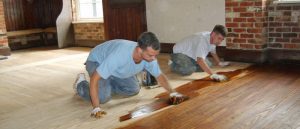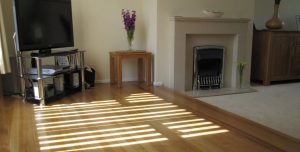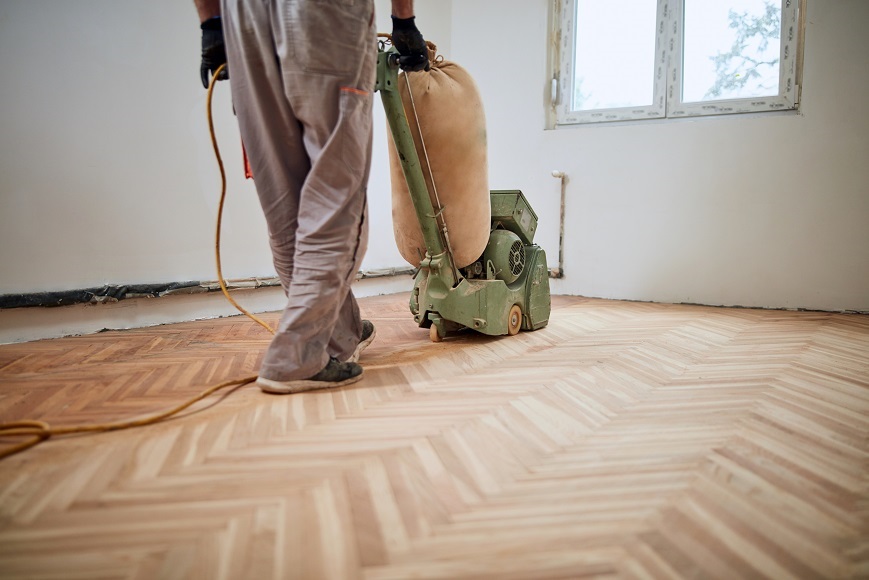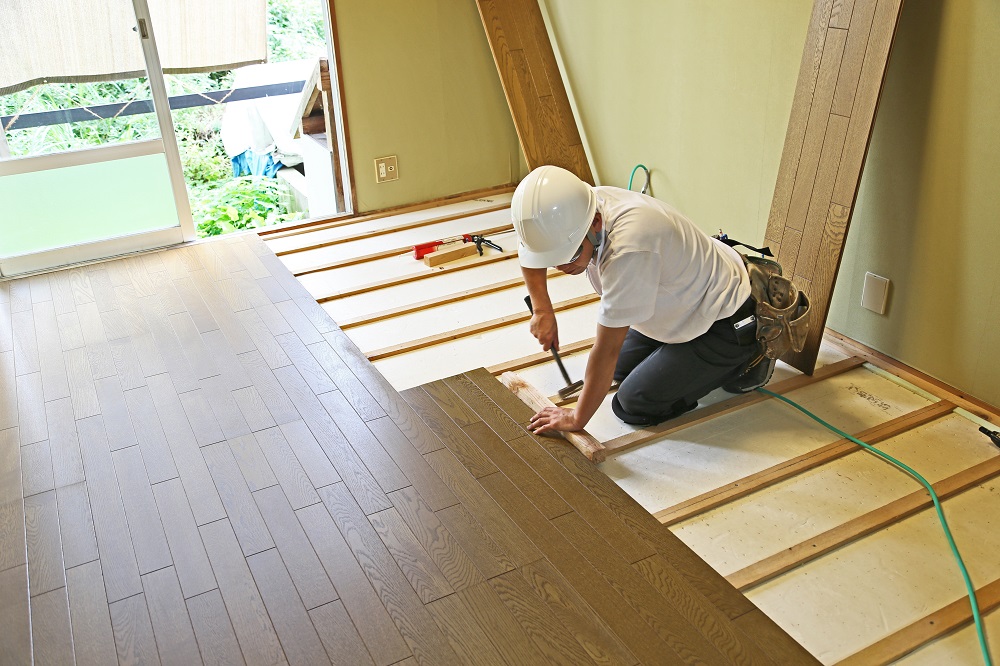To hire a professional or not? This is a major decision anyone planning on redecorating or renovating their home has to make. Which tasks do you tackle yourself, and which do you need an expert for?
When it comes to floor sanding, the decision should be made after a number of factors have been carefully considered: the type of hardwood floor, the size of the room, and your budget for the entire project. If your floor is dull and faded but doesn’t have deep scratches, you may be able to revive it by applying a fresh coat of polyurethane over the top without having to sand or stain it. This typically costs about half as much as a full refinish project, so it’s worth exploring if the floor’s condition isn’t too bad.
What To Expect With DIY Wood Floor Refinishing
Choosing to refinish your hardwood floors is brave but comes with many risks and a lot of potential hidden costs. For instance, if your floor has already been sanded down several times, the wood might be too thin for another refinishing job and would need to be replaced. You will also need to use the correct equipment and supplies, such as varnish, an electric floor sander, the sized sandpaper, a brush, a hammer, a bucket, and a mop. All these items are necessary to successfully refinish those floorboards, and the price can quickly add up.
In addition, it takes a lot of skill to control the sander efficiently; you could be creating hills and valleys as you go along and not even know it. Even though the bare floor may look fine after you’ve sanded it, you might miss flaws that become visible only after the finish has been applied. If this is the case, once completed, the floor will have an ugly-looking appearance, which will do nothing for your home’s value.
The Benefit of Sanding Your Floor Yourself
One of the major benefits of choosing to sand your floors yourself is the cost. Professional installation will require more financial commitment, which for some homeowners may be too expensive. However, we recommend you only choose this option and attempt this type of project if you have some experience with floor installation. Even then, conducting some basic research would go a long way towards ensuring a great finish.
Common Sanding Mistakes Made by DIYers
One of the reasons why floor sanding is such a risky technical job is that most mistakes are only visible after the project has been completed. What causes these mistakes?
Inconsistent Staining
This a pretty common mistake we see all the time. A lot of individuals who are trying to stain their floors darker, especially open grain woods like oak, do not realize that if two boards are sanded differently they’ll accept the stain differently.
The use of the wrong grit sandpaper This is probably the biggest mistake anyone can make. The grit sandpaper you use should depend on the conditions of your floorboards. If they’ve been sanded before and just need to be refreshed, you should be fine with finer grit sandpaper. However, in most cases, you’ll have to use a much coarser paper than you expect.

Poorly Applied Stain and Finish
Only specialists have access to the full range of products for stains and finishes because only the most basic options are offered on retail shelves. Your options as an individual will be very limited. Professionals have access to higher quality formulas that dry fast, last a long time, and look much better after the job is complete.
Sloppy Edging
Edging a wood floor is tedious and exhausting work, especially if you’ve just spent several hours using a drum sander. As a result, you might find yourself rushing through this part of the wood floor restoration process. When this happens, there will be a noticeable texture/colour difference around the edge of the room, which causes those areas to have a much higher risk of degradation.
Insufficient Cure Time
Not waiting for the finish to properly dry before using the floors is a rookie mistake a lot of homeowners make. The touch test can be very misleading; even though it may feel dry and the floor feels ready, it often is not. Depending on the finish used, it takes anywhere between two and five days before your floor fully cures.
Not Properly Removing The Old Finish
Removing the old finish is obviously the first step anyone would think of, but even this can be tricky. Planetary sanders (which are readily available at hardware stores) lack the power to remove an old finish effectively. You will quickly find that after several hours of sweating in a dust-filled room, you’ve hardly made a dent. Why not put that sander down and call a professional?
The Benefits of Hiring a Professional Floor Sander
Dust Control The floor sanding process is very messy; without the right equipment, you’ll quickly find that a giant cloud of dust is filling the air in your home and settling onto your furniture and nearby surfaces. This does not only create a huge mess for you to clean up, but inhaling this dust or getting it in your eyes can pose a serious health risk. This is why it’s better to hire a professional sander. A professional sander will have the right equipment and knows the techniques to use to control dust when sanding your floor.
Reduced Risk A professional will be less likely to make mistakes; if he does make them, he’ll know how to fix them properly and without damaging your floors.
Experience
Understanding how to properly use the different flooring materials needed for the floor sanding process can be tough for the inexperienced. The way a wood tile is handled is completely different from how wood panels are. Only a professional will understand how to work with whatever you have in order to deliver high-quality results. In addition, with so many floor finishing options in the market, only a professional floor sander would be able to offer advice on the most suitable sealant for your floors to get the best results and durability.

Peace of Mind
The entire floor sanding process requires a lot of decision-making. You need to decide the type of tools to use, the best product to use, and so on. This can quickly become very stressful. You can free yourself from this kind of stress or from any other pressure by working with a professional; he/she will handle all the heavy lifting on your behalf.
Professional Finishes
Experts use techniques that they have studied and mastered overtime to produce finishes that are hard to replicate. They go through years of training just to ensure they can deliver a specific result. In addition, there are techniques that only the experts and those who have undergone proper training can know.
How Long Will it Take a Professional to Sand My Floor?
On average, professionals can sand about 1,500 to 2,000 square feet in one day, depending on the condition of the wood. Newly installed, unfinished hardwood is easier to sand; re-sanding treated or older hardwood flooring will take more time.
This is not an indication of how much time it would take you to do the same job. If a professional will take about two hours to sand a living room floor, it might take you about two to three days to sand a room of the exact same size.
On a final note If it is the first time you are having your floors refinished, you’ll probably be better off hiring a professional. Not only will your floors look better, but they will also last longer and be finished much faster. If you try to sand the floor yourself, it can become too thin, and you may find you have permanently ruined an expensive hardwood floor. You should also consider the value of your time as opposed to the small amount of savings you’ll gain by doing this task yourself. Call a professional today.









